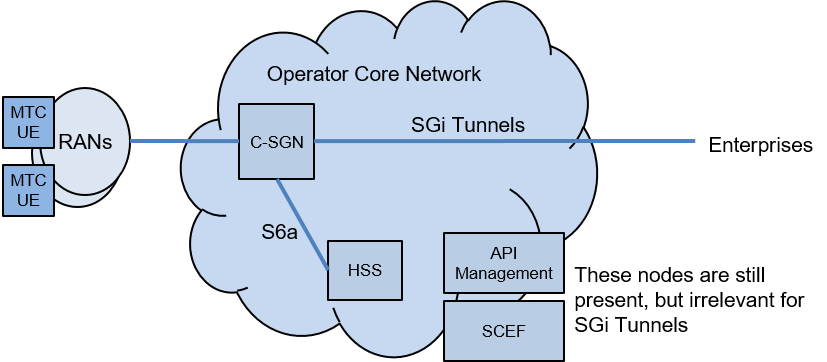NB-IoT NIDD via SGi Tunnel
While NIDD (Non-IP Data Delivery) has been standardized by 3GPP to use the SCEF, 3GPP has also defined a compromised approach called “SGi Tunnel” in 3GPP TS 23.682, with additional details available in 3GPP TS 23.401.
Both approaches, SCEF and SGi Tunnel, were defined at the same time by 3GPP. Why two approaches? This web page provides the clarifications.
Standardization Compromise
Let’s start with a simplistic view of the Operator’s network.

How can NIDD be accomplished between Devices and Applications, while minimizing the number of new network nodes and interfaces that need to be defined? That is the question addressed by the SGi Tunnel solution. The result is a compromise to standardization, requiring some new standards and much proprietary configuration.
Below, we see the SGi Tunnel solution.

Within the Operator’s Core Network, the SGi Tunnel endpoint is the PGW portion of the C-SGN. [PGW may be implemented as a separate node from the C-SGN.] The S6a endpoints are the HSS and the MME portion of the C-SGN.
There are many options for the tunnel methodology between P-GW and the Application Server (AS). Signaling or pre-configuration has not been standardized, so a significant portion of this SGi Tunnel solution is proprietary, in order for both ends of a tunnel to agree as to how to associate a particular tunnel with a particular UE.
Feature Compromise
This approach has the obvious major compromise of not allowing the applications to use desirable RESTful APIs (with SCEF) for NIDD. APIs are the future for accessing 3GPP networks. A Common API Framework (CAPIF) has been defined by 3GPP in TS 23.222, which is applicable for both today’s 3GPP networks and the new 5G Core (5GC).
This approach also forgoes an essential feature for exposing services, i.e., the capability to use an External Identifier to specify a particular device or group of devices. External Identifier may be used between Applications and SCEF, because SCEF has the S6t-interface with the HSS to resolve the External Identifier.
There are multiple technical issues with the SGi Tunnel approach, too. For example, NB-IoT is intended for high-latency devices, i.e., devices that might be sleeping for long periods of time. The need for extended buffering is part of the SCEF design requirements, but not present in existing nodes like PGW and SGW.
In hindsight, we see that this compromised approach to enable NIDD for NB-IoT was simply not necessary. There was no onslaught of NB-IoT devices to be deployed needing a NIDD solution. Instead, the 3GPP standards and availability of protocol upgrades in network nodes came about more quickly than the NB-IoT devices.
